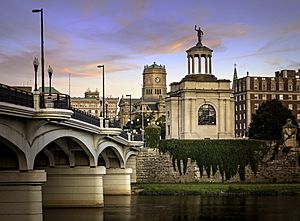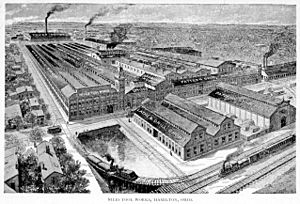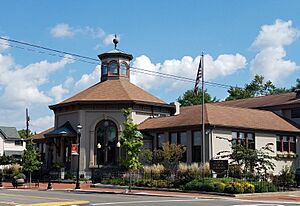Hamilton, Ohio facts for kids
Quick facts for kids
Hamilton, Ohio
|
|
|---|---|

High-Main Street bridge in downtown Hamilton, 2018
|
|
| Motto(s):
"An Award Winning Community"
|
|
| Country | United States |
| State | Ohio |
| County | Butler |
| Area | |
| • Total | 21.89 sq mi (56.70 km2) |
| • Land | 21.45 sq mi (55.56 km2) |
| • Water | 0.44 sq mi (1.15 km2) |
| Elevation | 587 ft (179 m) |
| Population
(2020)
|
|
| • Total | 63,399 |
| • Estimate
(2023)
|
62,997 |
| • Density | 2,955.66/sq mi (1,141.18/km2) |
| Time zone | UTC−5 (Eastern (EST)) |
| • Summer (DST) | UTC−4 (EDT) |
| ZIP code |
45011-15, 45018
|
| Area code(s) | 513 |
| FIPS code | 39-33012 |
| GNIS feature ID | 1085809 |
Hamilton is a city in Ohio, United States. It is the main city of Butler County. Hamilton is about 20 miles (32 km) north of Cincinnati. It sits along the Great Miami River.
Hamilton is the second-largest city in the Cincinnati metropolitan area. It is also the tenth-largest city in Ohio. In 2020, about 63,399 people lived there. Most students in the city go to schools in the Hamilton City School District.
Contents
History of Hamilton, Ohio
Fort Hamilton: A Strong Start
Hamilton started as Fort Hamilton in 1791. It was named after Alexander Hamilton. This military fort was built to help supply soldiers. These soldiers were led by generals Arthur St. Clair and Anthony Wayne. Their goal was to move the Shawnee and Miami people out of the Miami Valley. The United States wanted to open this land for new settlers.
The fort was built by the Great Miami River. The river was shallow and easy to cross. By 1800, the fort was no longer used. Hamilton then began to grow as a farming and trading town. The town was officially planned and named by 1803.
Becoming a City: Hamilton's Journey
Hamilton first became an official town in 1810. But it lost this status in 1815 because it did not hold elections. It became a town again in 1827, joining with Rossville. Rossville was a community across the Great Miami River. The two separated in 1831 but joined again in 1854. Hamilton became a city in 1857. It was also chosen as the main city, or county seat, for Butler County.
Abraham Lincoln's Visit
On September 17, 1859, Abraham Lincoln visited Hamilton. He gave a speech to support William Dennison, who was running for Ohio governor. Lincoln started his speech by saying the Miami Valley was "the garden spot of the world." This visit helped make Lincoln known as a possible future president.
Hamilton's Manufacturing Power
By the mid-1800s, Hamilton was a big manufacturing city. Early factories made machines for farms. These included steam engines, hay cutters, and threshers. Other factories made tools, paper, carriages, and guns.
In the early 1900s, Hamilton was a center for heavy manufacturing. Factories made large items like safes, machine tools, and paper-making machines. They also made parts for trains and cars. During the World Wars, Hamilton factories made supplies for the military. This included engines for ships and parts for guns. The Great Miami River valley became a huge industrial area.
The county courthouse was built between 1885 and 1889. It is famous for its grand design. Hamilton has three historic areas with old homes. Many German and Italian immigrants moved to Hamilton. Their cultures influenced the city's food and buildings. Jewish families also settled here. They built synagogues in the late 1800s and early 1900s.
Changes in Transportation and Economy
In the 1950s, the new highway I-75 was built. This highway went around Hamilton. This meant businesses moved to areas with easier highway access. Until 1999, Hamilton was one of the largest cities in the U.S. without direct highway access. The Butler County Veterans Highway later helped connect the city.
Later in the 1900s, many factories closed or moved. This caused many jobs to be lost in Hamilton. Like other cities in the "Rust Belt", Hamilton has worked hard to create new jobs. The city has kept many of its residents. It has also welcomed new immigrants, especially from Mexico and Latin America.
In 1986, the city council voted to add an exclamation point to the city's name. So, Hamilton officially became Hamilton! This was done to get more attention for the city. But maps and the federal government did not use the exclamation point. The city's website also does not use it today.
In 2009, Hamilton won an award for having the best-tasting city water in the United States. In 2010, it won a gold medal for the best water in the world!
Hamilton Hydraulic System
The Hamilton Hydraulic was a system built to power factories and mills. It helped Hamilton grow a lot between 1840 and 1860. Special canals and water storage areas brought water from the Great Miami River into the town. This water provided power for new industries.
The hydraulic system started about four miles north of Hamilton. A dam was built to send water into the system. Two reservoirs held water for the hydraulic. The main canal went south into the town. Water first flowed through the system in 1845. The flowing water turned millstones, powering factories. Many small industries were built along the hydraulic in the 1840s. One of these was the Beckett Paper Co.
The hydraulic was a main power source until the 1870s. Then, steam engines became more common and affordable. Most of the hydraulic canal was later covered or filled in. Even Henry Ford was interested in the hydraulic. After World War I, he built a factory in Hamilton to use its power. This factory later made car parts.
The Great Flood of 1913
Hamilton has had many floods over the years. But the biggest flood happened in March 1913. Heavy rain fell for five days, from March 25 to March 29. The ground was frozen, so most of the rain flowed into the rivers. About 9 to 11 inches of rain fell. This was like 30 days of water from Niagara Falls flowing through the valley.
In the Great Miami River Valley, 360 people died. About 200 of them were from Hamilton. Some drowned, and others died from sickness. The flood caused about $100 million in damage. This would be $2 billion today. The flood waters were so strong that they destroyed all four of Hamilton's bridges in just two hours.
In Hamilton, the water rose very quickly. It was 3 to 8 feet deep downtown. In some areas, it was up to 18 feet deep. Many people were trapped in their homes. Some had to break through their roofs as the water rose higher. The water was near freezing, and the current was very fast. The water was also dirty with sewage and dead animals. About 10,000 people, nearly one-third of Hamilton's population, lost their homes. Thousands of houses were destroyed or too damaged to fix.
Miami Conservancy District: Flood Control
After the terrible 1913 flood, people realized they needed a better plan. Cities in the valley worked together to prevent future floods. They created the Miami Conservancy District. This was a new type of organization. It was approved by the state and signed into law by Governor James Cox.
By 1915, engineers planned a system to control floods. This included making river channels better, building levees (walls to hold back water), and creating storage basins. These basins would temporarily hold extra rainwater. The system was designed to handle even more rain than in 1913. It has stopped floods over 1,000 times. Construction started in 1915 and finished in 1923.
The Miami Conservancy District was the first of its kind in the nation. It became an example for flood control everywhere. It is special because it was built and paid for by the people who benefit from it. Property owners in the area pay a fee. This fee helps keep the system working and protects the community from floods.
Chem-Dyne Toxic Waste Site
The Chem-Dyne site is a hazardous waste dump on the east side of Hamilton. In 1982, the government said that dangerous chemicals were found there. These included things like arsenic, cyanide, and other harmful substances. These chemicals could cause serious health problems.
The government filed a lawsuit to make the company help clean up the site. They also asked for money to cover the cleanup costs. The site is still being monitored.
Geography of Hamilton
Hamilton covers about 22.08 square miles (57.19 square kilometers). Most of this area is land, about 21.60 square miles (55.94 square kilometers). The rest is water, about 0.48 square miles (1.24 square kilometers).
Population Changes
| Historical population | |||
|---|---|---|---|
| Census | Pop. | %± | |
| 1820 | 660 | — | |
| 1830 | 1,079 | 63.5% | |
| 1840 | 1,406 | 30.3% | |
| 1850 | 3,210 | 128.3% | |
| 1860 | 7,223 | 125.0% | |
| 1870 | 11,081 | 53.4% | |
| 1880 | 12,122 | 9.4% | |
| 1890 | 17,565 | 44.9% | |
| 1900 | 23,914 | 36.1% | |
| 1910 | 35,279 | 47.5% | |
| 1920 | 39,675 | 12.5% | |
| 1930 | 52,176 | 31.5% | |
| 1940 | 40,592 | −22.2% | |
| 1950 | 57,951 | 42.8% | |
| 1960 | 72,345 | 24.8% | |
| 1970 | 67,865 | −6.2% | |
| 1980 | 63,189 | −6.9% | |
| 1990 | 61,436 | −2.8% | |
| 2000 | 60,690 | −1.2% | |
| 2010 | 62,447 | 2.9% | |
| 2020 | 63,399 | 1.5% | |
| 2023 (est.) | 62,997 | 0.9% | |
Hamilton's Population in 2020
In 2020, Hamilton had 63,399 people. This means there were about 2,955 people per square mile. There were 27,392 homes in the city.
Most people in Hamilton (74.6%) were White. About 9.9% were Black or African American. Other groups included Native American (0.6%), Asian (0.9%), and Pacific Islander (0.4%). About 6.1% were from other races, and 7.5% were from two or more races. About 10.0% of the population was Hispanic or Latino.
Of the households, 31.7% had children under 18 living with them. About 36.8% were married couples. The average household had 2.49 people. The average family had 3.14 people.
About 23.4% of the people were under 18. Most people (61.4%) were between 18 and 64. About 15.2% were 65 or older. The average age was 35.1 years. For every 100 females, there were about 93.4 males.
The average yearly income for a household was about $52,995. For families, it was about $62,579. About 19.6% of the people lived below the poverty line. This included 29.3% of those under 18. About 56.3% of the people had jobs.
Arts and Culture in Hamilton

Hamilton has three special Historic Districts. These are Dayton Lane, German Village, and Rossville. The city is working to grow its arts scene. In 2000, it called itself the "City of Sculpture." This led to many sculptures being placed around the city. The Pyramid Hill Sculpture Park was also created.
Lane Public Library System
The Lane Public Library is in a beautiful old building in German Village. It was built in 1866 by Robert Clark Lane. The library has been updated many times. Robert Lane gave the library its first 3,000 books. Today, it has over 123,000 books and other items. It also has a special room for local history and family research. The library also has a technology center downtown.
Sports in Hamilton
Hamilton has a history with minor league baseball. Teams played here in 1884, 1889, 1911, and 1913. These teams were called the Hamilton Mechanics.
The Hamilton Joes are a summer baseball team for college players. They play in the Great Lakes Summer Collegiate League. The team is named after famous baseball player Joe Nuxhall. The Joes started in 2009. They won the league championship in 2010 and 2016. Many former Joes players have gone on to play professional baseball.
The West Side Little League of Hamilton has played in the Little League World Series many times. They went in 1991, 1993, 2007, 2010, and 2021. In 2021, they made it to the championship game. West Side Little League has also won the state championship 19 times since 1988.
Education in Hamilton
The Hamilton City School District serves the city. It includes Hamilton High School. The district is spending $200 million to build new schools. This includes eight new elementary schools and a new freshman school. Two middle schools are being renovated. The high school is also getting new gyms, a media center, and classrooms. In 2002, President George W. Bush visited Hamilton High School. He signed the No Child Left Behind Act into law there.
Small parts of Hamilton are served by other school districts. These include the Talawanda City School District and the Ross Local School District.
Hamilton also has private schools. Father Stephen T. Badin High School is a Catholic high school. There are also several Catholic elementary schools. Richard Allen Schools, a charter school system, has a campus in Hamilton.
Miami University has a campus in Hamilton. Miami University Hamilton opened in 1968. It now has over 5,000 students.
Transportation in Hamilton
The Hamilton train station is not currently used for passengers. It used to have trains going to Detroit, Chicago, Washington, and New York City.
The Butler County Regional Transit Authority provides bus service in Hamilton. You can take buses to nearby cities like Middletown and Oxford. You can also connect to buses that serve the greater Cincinnati area.
Notable People from Hamilton
- Denicos Allen, football player
- William Allen, former U.S. Congressman
- Jim Blount, newspaper editor
- Leroy "Sugarfoot" Bonner, guitarist for the Ohio Players
- Frank Clair, Canadian Football League coach
- Ray Combs, comedian and TV host
- Aaron Cook, professional baseball player
- Sheehan Donoghue, Wisconsin assemblyman
- Robert Dove, U.S. Senate Parliamentarian
- Greg Dulli, musician
- Byron Elliott, Indiana Supreme Court Justice
- Warren Gard, former U.S. Congressman
- Kevin Grevey, professional basketball player
- Ronald Hamilton, opera singer
- Jon Hoke, football coach
- William Dean Howells, author
- Fannie Hurst, author
- Steven Ittel, chemist
- David Klarich, politician
- Eric Lange, actor
- Mark Lewis, professional baseball player
- Joshua L. Liebman, rabbi
- John Martinkovic, NFL player
- Robert McCloskey, children's author and illustrator
- Patrick McCollum, naturalist
- Kevin McGuff, college basketball coach
- Steve Morse, guitarist
- William Pitt Murray, Minnesota politician
- Pamela Myers, actress
- Jane Nelson, Texas Secretary of State
- Joe Nuxhall, professional baseball player
- Adam Pankey, NFL football player
- Patricia Parris, voice actress
- Mark Peck, New Zealand politician
- Nan Phelps, artist
- Katherine K. Preston, musicologist
- Floyd "Breezy" Reid, American football player
- Frederick Rentschler, aircraft engine designer
- Charles Richter, creator of the Richter scale
- James Ruppert, mass murderer
- George A. Sanderson, former Secretary of the U.S. Senate
- Paul Sarringhaus, NFL player
- David Shaw, musician
- Fannie Douglass Smith, journalist
- Simon Stepaniak, NFL player
- Van Stephenson, musician
- John Cleves Symmes Jr., soldier and philosopher
- Pat Tabler, professional baseball player
- Jim Tracy, professional baseball player and manager
- Roger Troutman, singer and songwriter
- Scott Walker, musician
- Brad Warner, zen priest and author
- Andrew R. Wheeler, former EPA Administrator
- Jane Delaplaine Wilson, author
- Andrew Wyant, author and fitness entrepreneur
- Jimmy Wynn, MLB player
See also
 In Spanish: Hamilton (Ohio) para niños
In Spanish: Hamilton (Ohio) para niños





